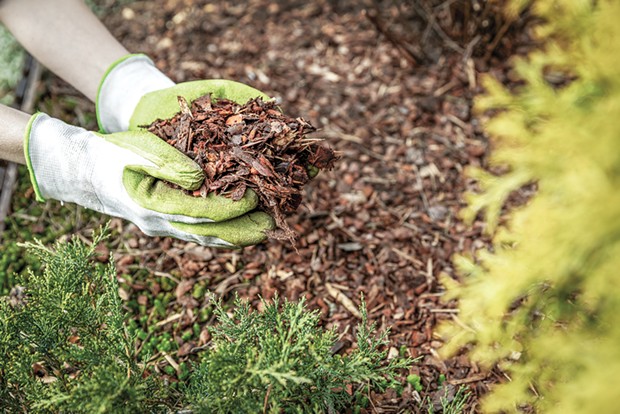[
{
"name": "Top Stories Video Pair",
"insertPoint": "7",
"component": "17087298",
"parentWrapperClass": "fdn-ads-inline-content-block",
"requiredCountToDisplay": "1"
}
]
Well, we survived the first major heat wave of the year, or at least my garden did — barely. And I'm on the coast. Inland, it was a whole different story. I hope all your crops and ornamental plants survived.
Because this likely isn't a "one and done" event, here are some tips to keep your garden (and you) cool during the summer.
Mulch is your friend. No matter the plant, whether veggies, fruit trees, shrubberies or flowers, they all appreciate having cool roots. Which mulch you use is up to you. I'm a fan of the shredded redwood bark, as well as microbark, though woodchips will do as well. If you're mulching an area that tends to get weedy, put down a thick layer of newspaper or cardboard before applying the mulch. Remember to keep the mulch away from the stems of the plants or else it could hasten rot. Think donut, not volcano.
You can purchase mulch at your local garden center or at one of the landscaping supply companies in the county. You can also get woodchips at some of the many piles that tree companies dump on the side of the road. There's a spot off State Route 299, as well as an area up near Trinidad. Many tree companies will bring a load of woody debris to your place if you call them. But be warned, they may drop upwards of 10 yards of mulch. It's also important to find out what sort of tree debris is in the load, as there are a few trees that can cause problems with your garden, leaching allelochemicals into the soil, which can kill nearby vegetation. A few to avoid include black walnut, tree of heaven, magnolia and eucalyptus.
Mulch will eventually break down into the soil, providing nutrients for the plants and earthworms, so you'll need to reapply every year or so.
Watering when it's going to be very hot is a good idea but not in the heat of the day. Ideally, watering early in the morning will allow the water to leach into the soil before it evaporates in peak temperatures. Late evening is an OK time to water, though morning is preferable.
Do not overhead water if you can help it. Upwards of 20-25 percent of water can be lost to evaporation if you water during the day. Drip or soaker hoses are much more efficient, as they put water only where it's needed. Overhead watering can also cause problems with some plants, such as squashes. Due to our high humidity, they can develop powdery mildew on the leaves. Stick with drip or soaker hoses if you can. If you only have plants in pots, just be careful when watering them so as to not get water on the leaves. Potted plants also generally need more water than plants in the ground due to drying out more quickly.
It's also possible to overwater, especially potted plants. If they start to turn yellow, it may be due to too much water. Some plants, such as lemon trees and camelias, turn yellow from iron deficiency, also known as chlorosis. A good citrus fertilizer can get the iron balance back into shape.
Now that you have a basic idea of how to keep your plants from expiring in too much heat, let's move on to what you should be looking for in your garden.
Garlic. You've checked your garlic, right? If you haven't, now is the time to do so. If you have hardneck garlic, it should have put out scapes by now, and you definitely want to snap them off so the energy goes into the bulb(s), not the flower stalk. Garlic scapes can be used, you know. Cut off the woody part, then dice finely and sauté in some olive oil and add to stir fries, eggs or any dish that can use a little garlic. When the lower two leaves on the stalk turn brown and the tips of the leaves turn yellow, it's usually time to harvest. Not sure if they're ready? Dig a couple up and look. Make sure you cure the garlic before putting it into storage. It can rot if you don't take this step. Place garlic in an airy spot out of direct sunlight. After about two weeks, sometimes up to four, the papers on the outside of the garlic will have dried out and you can put it in storage, or braid it if you're feeling adventurous (and if you have softneck garlic — hardneck won't cooperate).
After you've harvested the garlic, now what? Put in a fall crop! Amend the soil a bit with some quality compost and a basic 4-4-4 fertilizer so that the crops get a good start. Crops to plant after your garlic is harvested includes brassicas (kale, broccoli, cabbage, etc.), carrots, beets, spinach and peas, among others.
It's also a good time to prune your flowering shrubs, right after the bloom is finished. "Prune after bloom" is the general rule. I've seen some folks prune right before the blooming period, which will take off all the blooms for next year. Don't do that. Deadheading flowers is another good garden task right now. Roses will even put out more blooms if you deadhead them, as will sweet peas.
And finally, if and when we get another hot spell, make sure you put on your sunscreen, wear a hat and stay hydrated before heading out to the garden or yard. Save the refreshing adult beverages for later in the day.
Julia Graham-Whitt (she/her) is owner and operator of the landscaping business Two Green Thumbs.
more from the author
-
Working it Out in the Garden
- Jan 18, 2024
-
Winter Planting for Future Color
- Dec 21, 2023
- More »
































